

Original Article - Year 2013 - Volume 28 -
Medida do grau de correção das orelhas proeminentes utilizando algoritmo de tratamento padronizado
Assessment of the degree of correction of prominent ears using a standardized treatment algorithm
RESUMO
INTRODUÇÃO: O objetivo da otoplastia estética é a correção de deformidades da orelha, criando orelhas externas harmoniosas e simétricas. As técnicas de otoplastia, baseadas na excisão da pele pós-auricular, estão associados com a recorrência elevada. A otoplastia moderna é baseada nas técnicas de ressecção e/ou modelagem da cartilagem, que levam a menores taxas de recorrência.
OBJETIVO Foi avaliada a eficácia da otoplastia com técnica combinada na correção de deformidades da orelha, baseado numa versão modificada do "algoritmo para otoplastia", no Centro Craniofacial do Hospital Infantil do Texas".
MÉTODO: Quarenta pacientes submetidos à otoplastia por orelhas proeminentes, entre março e setembro de 2009, foram avaliados prospectivamente. A distância mastoide-hélice foi medida no pré-operatório e após 1, 3 e 6 meses após a cirurgia.
RESULTADOS: As deformidades mais comuns foram ângulo escafo-conchal maior que 90º (51,3%, 41/80 orelhas) e hipertrofia de concha> 2,5 cm (46,3%, 37/80 orelhas). Reduções significativas na distância mastoide-hélice foram observadas nos três períodos em comparação com os valores basais (P<0,001). Houve uma redução desta medida no período pós-operatório imediato (P<0,001), seguido por um pequeno aumento após três meses da cirurgia (P<0,005) e subsequente tendência de estabilização entre 3-6 meses após a cirurgia (P=0,520).
CONCLUSÃO: Otoplastia, realizada de acordo com o algoritmo citado, resultou em redução significativa da distância mastoide-hélice, com ligeira perda desta redução no início do período pós-operatório, e com tendência a manter-se inalterado após 6 meses de pós-operatório.
Palavras-chave: Orelha externa. Otoplastia. Deformidades.
ABSTRACT
BACKGROUND: The goal of aesthetic otoplasty is the correction of ear deformities by creating harmonious and symmetrical external ears, without visible scars. Otoplasty techniques based on the excision of postauricular skin are associated with high recurrence rates. Modern otoplasty is based on cartilage-cutting and cartilage-sparing techniques, alone or in combination, which lead to lower recurrence rates.
OBJECTIVE: We evaluated the efficacy of otoplasty combined with other techniques in the correction of ear deformities, based on a modified version of the "algorithm for otoplasty at the Craniofacial Center at Texas Children's Hospital".
METHODS: Forty patients, who underwent otoplasty for prominent ears in our institution between March and September of 2009, were prospectively assessed. The mastoid-helix distance was measured preoperatively (baseline) and at 1, 3, and 6 months postoperatively.
RESULTS: The most common deformities were scaphoconchal angle greater than 90º (51.3%, 41/80 ears) and conchal hypertrophy > 2.5 cm (46.3%, 37/80 ears). Recurrence occurred in 2 (5%) patients and partial stenosis of the ear canal in 1 (2.5%). Significant reductions in the mastoid-helix distance were observed at the three time points compared with baseline (P<0.001); a significant reduction was present in the immediate postoperative period (P<0.001), followed by a small increase 3 months postoperatively (P<0.005), which appeared to stabilize between 3-6 months postoperatively (P=0.520).
CONCLUSION: Otoplasty performed according to the modified algorithm resulted in a significant reduction of the mastoid-helix distance, which slightly increased in the early postoperative period, and re-mained unchanged 6 months postoperatively.
Keywords: Otologic surgical procedures. Ear, External. Deformities.
As deformidades auriculares são relativamente frequentes, sendo relatada a incidência em 5% da população caucasiana 12. Em cerca de 60% dos casos, pode ser diagnosticada ao nascimento. O restante dos casos será diagnosticado na primeira infância 1. Os defeitos mais comumente vistos em portadores de orelhas proeminentes são a ausência ou a redução do ângulo escafoconchal (anti-hélice), concha hipertrófica ou mais profunda, indefinição da margem da hélice e anormalidades do lóbulo. Assim, os portadores desta má-formação podem apresentar uma ou mais características supracitadas 15.
O objetivo da otoplastia é corrigir os diferentes graus de deformidade, a fim de obter orelhas esteticamente harmoniosas, simétricas e sem sinais aparentes de correção cirúrgica 2. Este trabalho objetiva analisar a eficácia da otoplastia com diferentes técnicas de correção de orelhas proeminentes, baseada numa versão modificada do algoritmo de otoplastia do Centro Craniofacial do Texas Children's Hospital.
MÉTODO
O estudo foi aprovado pelo Comitê de Ética em Pesquisa do Hospital do Servidor Público Municipal de São Paulo (HSPM), Brasil, e realizado de acordo com os padrões éticos de 1964 Declaração de Helsinki e suas revisões seguintes. O consentimento informado, por escrito, foi obtido de todos os pacientes, ou seus representantes, antes de sua inclusão no estudo, e lhes foi assegurado o anonimato.
Foram avaliados, prospectivamente, 40 pacientes submetidos à otoplastia por queixa de orelha proeminente no Serviço de Cirurgia Plástica do HSPM entre Março e Setembro de 2009. Os pacientes participantes do estudo eram, em sua maioria, do gênero feminino (60%) com média de idade de 20 anos (8 a 55 anos). Os critérios de exclusão foram pacientes com idade inferior a 6 anos, com cirurgias de otoplastia anteriores, outras malformações da orelha externa. Os dados foram coletados através de um questionário padronizado e as distâncias mastóide-hélice foram mensuradas no pré-operatório e 1, 3 e 6 meses após a cirurgia (Fig. 4).
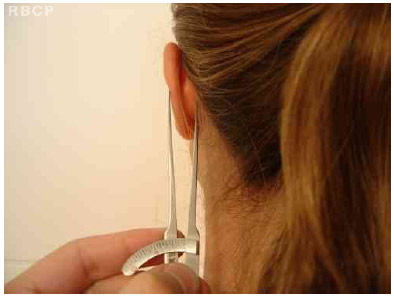
(Fig 4 ) Imagem da medida da distância mastóide-hélice com precisão bússola / compasso
Os pacientes foram submetidos a técnicas de otoplastia, com ressecção e/ou abrasão associada a técnica de sutura da cartilagem, seguindo o algoritmo modificado do Centro de Cirurgia Craniofacial do Texas Children's Hospital modificado 10,14. (Tabela 1) (Fig. 5-8)
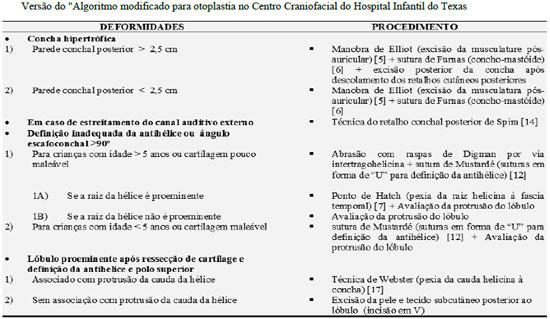
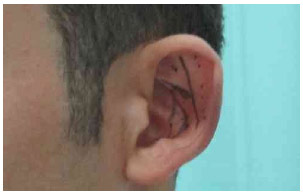
(Fig 5.) Pré-operatório, marcação de pontos de sutura conchal.
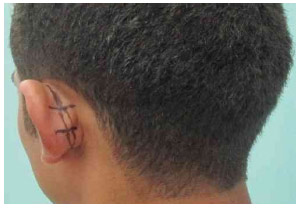
(Fig. 6) Pré-operatório, marcação da incisão retroauricular.
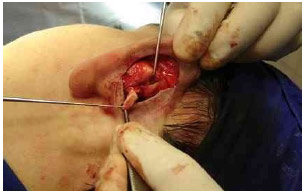
(Fig.7) Ressecção posterior do axcesso conchal seguida de sutura simples.

(Fig.8) Uma lima é passada através de uma fenda anteroauricular, e são marcados na superficie anterior o pericôndrio e cartilagem.
Os dados foram analisados pelo SPSS for Windows versão 15.0 (SPSS Inc., Chicago, IL), para análise exploratória de dados. Foi utilizado para o teste ANOVA com medidas repetidas. Nível de significância de 0,05 (p<0,05).
RESULTADOS
Dentre os indivíduos avaliados, 75% relatavam ser ridicularizados em seu ambiente de trabalho / estudo e 40% informavam baixa autoestima. Em 42,5% dos casos, possuíam familiares de primeiro grau portadores da mesma deformidade.
As deformidades mais freqüentes foram: ângulo escafoconchal maior que 90 graus (51,3% %, 41/80 orelhas) e hipertrofia conchal >2,5cm (46,3%, 37/80 orelhas) (tabela 2). Salientando que alguns pacientes apresentavam mais de um tipo de deformidade associada.
Os procedimentos mais realizados foram os pontos de Mustardé para definição da prega anti-helicina e de Furnas (pontos concho-mastóideos) (tabela 3).
As complicações mais freqüentemente encontradas foram dor (22,5%), extrusão de sutura (12,5%) e excesso cutâneo posterior (12,5%). Porém, as seqüelas mais debilitantes foram as recidivas (5%), a estenose parcial de conduto auditivo (2,5%) e as deformidades pós-operatórias precoces e residuais (tardias) (tabela 4).
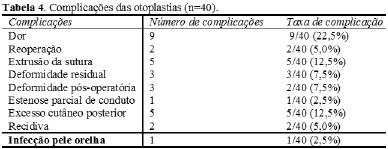
A variação observada nas medidas da distância mastóide-hélice durante o tempo mostraram-se estatisticamente significantes (p<0,001).
A otoplastia realizada segundo o algoritmo proposto, que combina técnicas de ressecção de cartilagem com técnicas de sutura e raspagem, cursou com diminuição média das medidas aurículo-mastóideas importante no primeiro mês, apresentando discreto aumento nos pós-operatórios 3º Mês e 6º Mês (tabelas 5 e 8 e as Figuras 1 a 3).




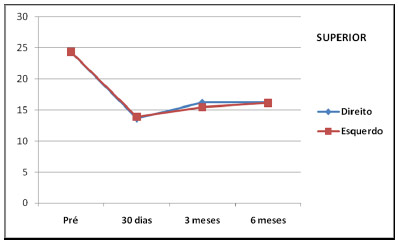
Figura 1. Distribuição das medidas da distância mastóidea-helicina nos pólos superiores dos pavilhões auriculares direito e esquerdo ao longo do estudo dos pacientes submetidos a otoplastia.
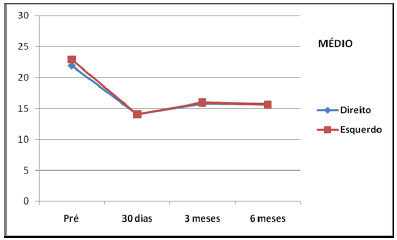
Fig 2. Distribuição das medidas da distância mastóidea-helicina nos pólos médios dos pavilhões auriculares direito e esquerdo ao longo do estudo dos pacientes submetidos a otoplastia .
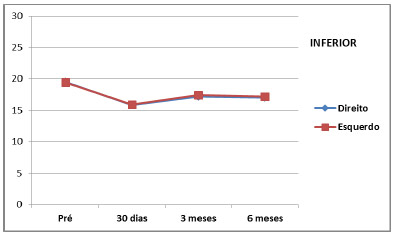
Fig 3. Distribuição das medidas da distância mastóidea-helicina nos pólos inferiores dos pavilhões auriculares direito e esquerdo ao longo do estudo dos pacientes submetidos a otoplastia.
DISCUSSÃO
As orelhas proeminentes são uma deformidade com prevalência relativamente alta na população, totalizando até 5% da população caucasiana 1,2. Isto indica a importância da otoplastia como parte da rotina do cirurgião plástico. Portanto, a identificação de parâmetros clínicos e dos desfechos cirúrgicos são de fundamental importância para a mensuração do resultado.
Estudos prévios que utilizaram a avaliação da distância mastóide-hélice como parâmetro, referem como parâmetros normais as distâncias de 10 a 12mm no pólo superior, de 15 a 18mm no nível do canal auditivo externo, e de 15 a 18mm ao nível da cauda da hélice 7,10,15. A avaliação do ângulo escafo-conchal pode ser imprecisa, pois demanda instrumental de precisão em contato com as referidas cartilagens num espaço restrito. Este mesmo autor cita a distância mastóide-helicina como: 1) leve, entre 15 e 20mm, 2) moderada, entre 20 e 24mm, 3) severa, entre 24 e 28mm e 4) totalmente anteriorizada acima de 28mm (3).
Outros autores consideraram aspectos estéticos, como a necessidade de corrigir qualquer protrusão do pólo superior, a helice deveria ser vista além da antihélice e deveria ser regular e de contorno suave e o sulco pós-auricular não poderia ser reduzido ou distorcido. Ainda, preconizavam que as orelhas deveriam estar simetricamente posicionadas, com formatos semelhantes 11 e com ângulo auriculo-mastóideo entre 20º e 30º (8,9).
As opções tradicionais de tratamento envolvem procedimentos de enfraquecimento da cartilagem antihelicina ( abrasão ou incisões), métodos de sutura, procedimentos de redução de hipertrofia conchal e/ou ressecção de pele retro-auricular 10. Neste estudo, as técnicas combinadas foram utilizadas conforme o tratamento de cada defeito específico seguindo o algoritmo do Centro de Cirurgia Craniofacial do Texas Children's Hospital modificado (Tabela 1) 5-7,10,12,14,15,17.
A medida mastóide-helicina foi um dos parâmetros utilizados para avaliar os resultados das otoplastias em nosso serviço. Foi escolhida por ser uma variável contínua, objetiva e passível de mensuração com compasso de precisão e régua milimetrada foi escolhida. Outros autores, utilizando a mesma medida, encontraram aumento ( em 71,7% dos casos até 3mm de aumento) nas medidas mastóideo-helicinas entre o pós-operatório imediato e o seguimento de 12 meses, sem significância estatística . Sugeriram então que, uma "supercorreção" antecipada não seria necessária, pois esta acomodação teria pequeno efeito no resultado das otoplastias 4.
As medidas mastóide-helicinas nos três pontos foram comparadas com a medida pré-operatória (p<0,001). Evidenciamos que a distância mastóide-helicina sofre redução significativa no pós operatório imediato, seguida de um aumento discreto desta medida nos primeiros meses, com tendência à estabilização entre 3 a 6 meses (figuras 1, 2 e 3). Assim, no caso da medida do pólo superior existe uma redução média superior a 10,7mm (p<0,001) com aumento posterior de 2,3mm até 3 meses, e manutenção desta medida até 6 meses .Notamos um declínio global e mantido das medidas mastóide-hélice nas curvas das figuras 1, 2 e 3. Isto pode ser atribuído a utilização deste algoritmo que destina técnicas adequadas para correção de cada deformidade na orelha.
As recidivas ocorreram em 2 casos, assim como a estenose parcial do canal auditivo foi o desfecho de um pós-operatório imediato. Destes, dois pacientes aceitaram a correção cirúrgica com resultados satisfatórios. A técnica do retalho de concha posterior de Spira foi utilizado na solução da estenose parcial do conduto auditivo. A sutura de Mustardé foi utilizada na recorrência por falta de definição da antihélice.
CONCLUSÃO
A otoplastia realizada, seguindo a versão modificada do algoritmo do Centro de Cirurgia Craniofacial do Texas Children's Hospital, levou a uma redução significativa da medida mastóide-helicina com discreto aumento no período até 3 meses. Ainda, existe uma tendência à manutenção do resultado entre 3 e 6 meses.O sequenciamento dos procedimentos em otoplastia, como sugerido no algoritmo, parece endereçar a melhor técnica ou associação delas a cada deformidade com o objetivo de reduzir a distância mastóide-helicina.
REFERÊNCIA
1.Aki F, Sakae E, Cruz DP, Kamakura L, Ferreira MC. Complicações em otoplastia: revisão de 508 casos. Rev Soc Bras Cir Plást. 2006;21(3):140-4.
2.Stal S, Klebuc M, Spira M. An algorithm for otoplasty. Oper Tec Plast Reconstr Surg. 1997;4(3):88-103.
3. Sperli AE. Oto-pericondrioplastia: atualização de técnica. Rev Soc Bras Cir Plást. 1998;13(3):7-18.
4. Schlegel-Wagner C, Pabst G, Müller W, Linder T. Otoplasty using a modified anterior scoring technique: standardized measurements of long-term results. Arch Facial Plast Surg. 2010;12 (3):143-8.
5. Lee KH, Pereira Filho OJ, Grangeiro LS, Neves CRZD, Bins-Ely J. Endotoplastia por incisão superior. Rev Bras Cir Plást. 2012;27(supl):42.
6. Kelley P, Hollier L, Stal S. Otoplasty: evaluation, technique, and review. J Craniofac Surg. 2003;14(5):643-53.
7. Janis JE, Rohrich RJ, Gutowski KA. Otoplasty. Plast Reconstr Surg. 2005;115(4):60e-72e.
8. Bhatti AZ, Adeniran A. Grading and scoring of prominent ears. Plast Reconstr Surg. 2006;118(2):582-3.
9. Naumann A. Otoplasty - techniques, characteristics and risks. GMS Curr Top Otorhinolaryngol Head Neck Surg. 2007;6:Doc04.
10. Braun T, Hainzinger T, Stelter K, Krause E, Berghaus A, Hempel JM. Health-related quality of life, patient benefit, and clinical outcome after otoplasty using suture tecniques in 62 children and adults. Plast Reconstr Surg. 2010;126(6):2115-24.
1. Doutorado. Médico Assistente do Serviço de Cirurgia Plástica e Queimaduras do Hospital do Servidor Público Estadual - Francisco Morato de Oliveira/SP - HSPE FMO. Ex-Residente de Cirurgia Plástica do Hospital do Servidor Público Municipal de São Paulo
2. Médico. Cirurgião plástico. Ex-Residente de Cirurgia Plástica do Hospital do Servidor Público Municipal de São Paulo
3. Médico. Residente de Cirurgia Plástica do Hospital do Servidor Público Municipal de São Paulo
4. Professor Assistente de Cirurgia Plástica do Hospital do Servidor Público Municipal de São Paulo
5. Médico Assistente do Serviço de Cirurgia Plástica do Hospital do Servidor Público Municipal de São Paulo, Professor Adjunto (Disciplina de Cirurgia Plastica da EPM/UNIFESP) e Orientador do Programa de Pós Graduação em Cirurgia Translacional EPM/ UNIFESP
6. Mestrado. Professor Assistente de Cirurgia Plástica do Hospital do Servidor Publico Municipal de São Paulo
Leonardo Gabeira Secco
Rua Dr. Veiga Filho, 350 cjs. 106 a 109; Higienopolis
CEP 01229-001 São Paulo, SP, Brazil
Tel.: +55 (11) 3822-0328; Fax: +55 (11) 3661-9502
E-mail: leonardosecco@uol.com.br
Artigo recebido:18/10/2012
Artigo aceito: 25/11/2012
Trabalho realizado no Serviço de Cirurgia Plástica do Hospital do Servidor Público Municipal de São. Paulo




 Read in Portuguese
Read in Portuguese
 Read in English
Read in English
 PDF PT
PDF PT
 Print
Print
 Send this article by email
Send this article by email
 How to Cite
How to Cite
 Mendeley
Mendeley
 Pocket
Pocket
 Twitter
Twitter